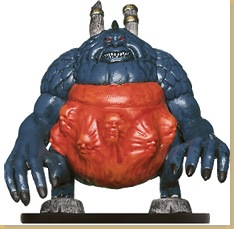I have never been a big fan of the alignment system in D&D. In the old days there were nine alignments: Lawful Good, Neutral Good, Chaotic Good, Lawful Neutral, (True) Neutral, Chaotic Neutral, Lawful Evil, Neutral Evil, and Chaotic Evil.
Unfortunately, often the names of the alignments were all the gamers in my group could agree on. What those alignments actually meant seemed to be different to each player. One player might argue it was ok for his Lawful Good Samurai to cut off the hand of the party thief because that was lawful in his society while other players considered it evil. Another might argue that his lawful neutral monk had to follow up on every thing he vowed to do while other players felt his behavior was chaotic because he could choose to vow to do anything. Who is right and who is wrong in these cases? It's hard to say.
Oddly, the Lawful Good alignment was one of the most problematic. Many Paladins and other players with this alignment felt forced to become "party police", much to the resentment of the other players. Those that didn't want that role were forced to become "Lawful Stupid" and feign ignorance to what was going on around them.
I suppose I should point out that I actually like the concept of alignment in some cases, mostly in the case of extraplanar beings who are often little more then the living embodiment of an ideal anyway. It just seems like it would be very difficult for natural beings to act within the rigid strictures of alignment.
When 4th Edition came out, they revamped the alignment system. Now there are only five alignments: Lawful Good, Good, Unaligned, Evil, and Chaotic Evil. They way they are described, they probably could be more accurately called "Really Good", Good, "Screw Alignments", Evil, and "Really Evil".
I don't consider this much of an improvement. It still has a most of the issues of the old system, with the only advantage being that there is an "opt out" button in the middle. Still, I like the concept that aligning yourself with a faction is a choice that not everyone makes. So it's a step in the right direction. The real question is: How can it be improved?
Luckily for me, I have no problem stealing drawing inspiration from other systems. So lets take a look at a few. Warhammer Fantasy has a Law versus Chaos setup similar to Dungeons and Dragons, which is not surprising since both were inspired my Michael Moorcock's
has a Law versus Chaos setup similar to Dungeons and Dragons, which is not surprising since both were inspired my Michael Moorcock's fantasy novels. I do feel that Warhammer does a better job of integrating the war of Law versus Chaos into its campaign setting, as well as highlighting the issues with the extremes of both sides. Perhaps some aspects of this can be put into the new system.
fantasy novels. I do feel that Warhammer does a better job of integrating the war of Law versus Chaos into its campaign setting, as well as highlighting the issues with the extremes of both sides. Perhaps some aspects of this can be put into the new system.
Another option is presented in Wizard's Oriental Adventures for the 3rd Edition game. They remove alignment entirely. Instead they use the concept of Honor and Taint. The Honor system basically keeps track of how well you stick to societies codes of conduct, while Taint measures how much the "evil" of the Shadowlands has infected your soul.
for the 3rd Edition game. They remove alignment entirely. Instead they use the concept of Honor and Taint. The Honor system basically keeps track of how well you stick to societies codes of conduct, while Taint measures how much the "evil" of the Shadowlands has infected your soul.
I actually like the concept of Taint a lot. It gives nice mechanics to a the concept that the natural and unnatural may not be meant to cross. I will admit, it has a more horror feeling to it than your average D&D game contains. As for Honor, it works well in Oriental Adventures and probably would work well in a campaign with a more "knightly" feel than your average D&D game. Still, there are some interesting concepts that could be incorporated into a new system.
White Wolf's new World of Darkness system provides some interesting mechanics as well. Rather than an overarching alignment system, each character chooses a Virtue and a Vice. Whenever the character indulges in a Virtue or a Vice, they gain a Willpower point.
system provides some interesting mechanics as well. Rather than an overarching alignment system, each character chooses a Virtue and a Vice. Whenever the character indulges in a Virtue or a Vice, they gain a Willpower point.
I like this a lot. By providing an incentive to indulge in both, I believe it encourages role-playing. Many heroes in literature are as well know for their flaws as their virtues. Conan was strong, brave, and had a strong sense of barbarian honor. Still, Conan was just as well know for overindulging in drinking or whoring.
Mixing and matching some concepts from these systems, and an interesting new model begins to emerge. Taking a cue from 4th Edition D&D, lets assume that most characters are unaligned. The unaligned would simply use a virtue and vice system similar to the one found in World of Darkness.
On the other hand, a character could choose to align themselves with extraplanar forces. This would provide additional benefits and additional penalties. It also would require an opt in to a stricter morality than those simply playing an unaligned character. It may take on some some aspects of "Taint", namely that your actions could move you up and down a scale and may have some physical effect on your character.
So where are the details? Well, in all honesty I don't have them. That's the reason I placed a "Part I" at the top of the article. I am going to be working on this alternative alignment system over the next couple of weeks. This post is the "fluff", while future ones will present the "crunch".
Also, while I believe this goes without saying, I will say it anyway. Since this is a work in progress, I would love to hear peoples comments and suggestions.

